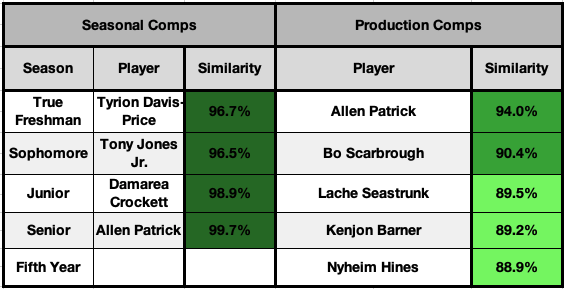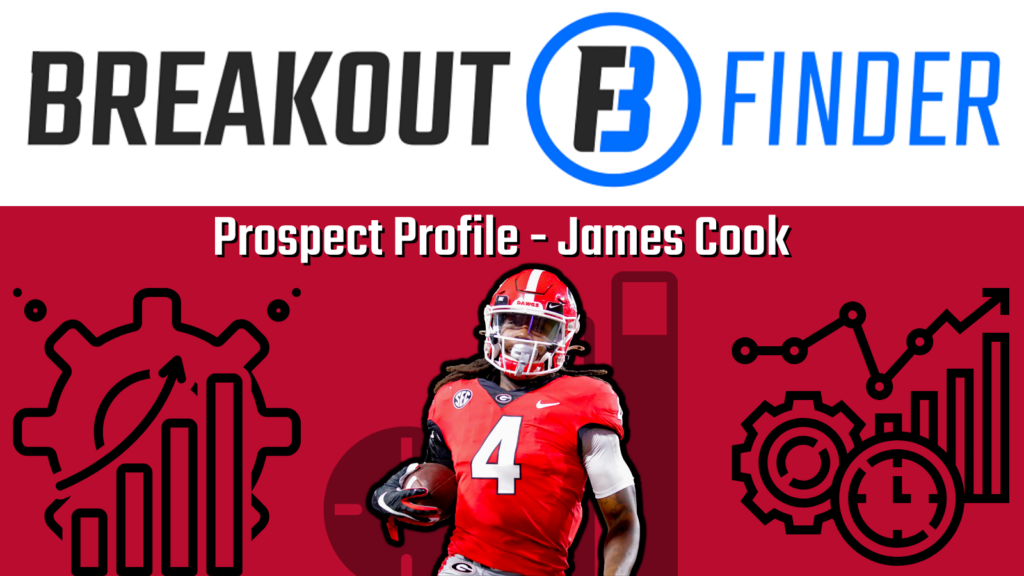
Georgia’s James Cook performed at 199-pounds at the Combine before bulking up to 204 at his Pro Day:
At nearly 6-feet tall, Cook is very skinny for an NFL running back at either of those weights. It’s good then that he balances that lack of size and density out with explosive athleticism. He has near-elite speed. While his vertical was bad, his broad jump showing is backed up by the high-end burst he shows on film.
Based on the above measurables, the following historical prospects were the most similar to Cook from a purely athletic standpoint. And then from an overall physical point of view:
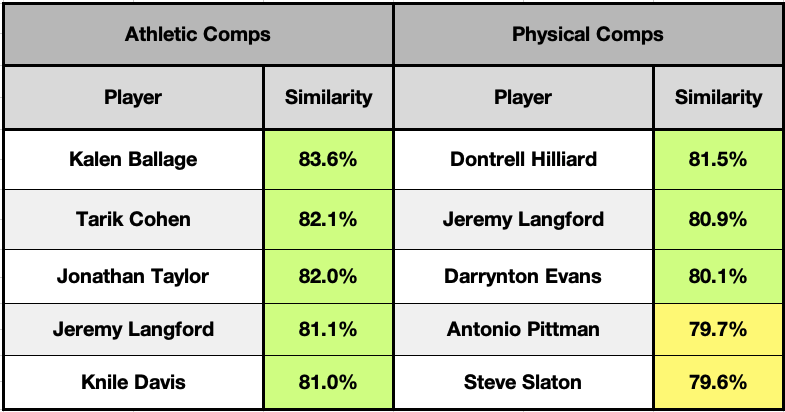
Many of these guys have been at least NFL contributors. And Cook should not have an issue with his movement skills as he transitions to the next level.
Production Profile
The most underwhelming aspect of James Cook‘s overall profile is his resumé of collegiate production:
Albeit on very strong teams and with other talented players competing for opportunities, Cook never really came close to posting anything like a breakout season in college. He touched the ball less than 100 times combined in his first two seasons. And just 140 times in his highest-volume season in 2021.
Given the seasonal Dominator Ratings he posted and the quality of teams he played for, the following historical prospects had the most similar seasonal numbers as well as complete college production profiles:
None of Cook’s individual seasons was very impressive. His closest production matches overall were mostly role players at big-time programs. Guys like this generally don’t go on to be super productive NFL runners.
Rushing Efficiency
I wrote a full breakdown of James Cook‘s rushing efficiency profile that can be found here. The following is a quick overview:
On very light volume, Cook outperformed a very talented group of teammates to a 75th-percentile degree on the ground. Along the way, he proved very dynamic in the open field. He managed to break tackles at an above-average rate despite his slight frame.
There’s a key piece of context in that team-relative efficiency. Cook played primarily on passing downs. As such, he ran into boxes that were significantly lighter than those his backfield mates ran against. Considering that advantage, his Box-Adjusted Efficiency Rating is just decent, and his Relative Success Rate is simply bad.
It’s worth pointing out that Cook became a significantly more effective runner as his career progressed:
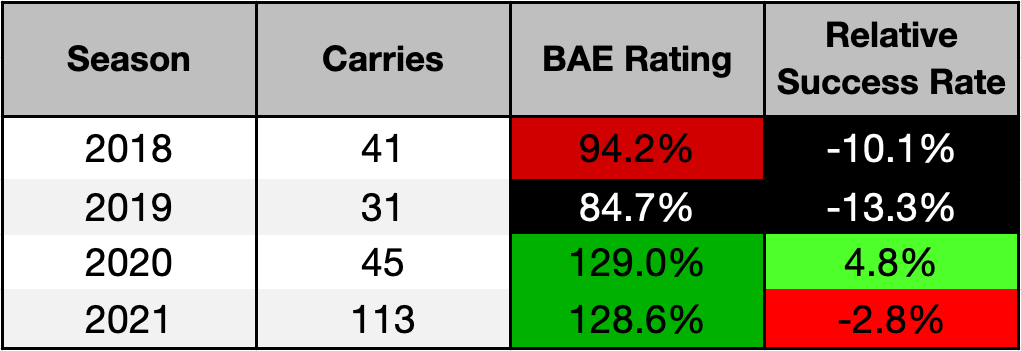
By the time he was an upperclassman, he was posting seasonal BAE Ratings on par with Jonathan Taylor‘s career marks. However, Cook’s career RSR mark of -4.0-percent seems fairly reflective of where he’s at in his development even now. He likely belongs to the archetype of small, speedy satellite backs; those who create big plays without offering down-to-down consistency between the tackles.
Given his physical profile in combination with the above metrics, the most similar historical prospects to Cook from a “pure runner” perspective are:
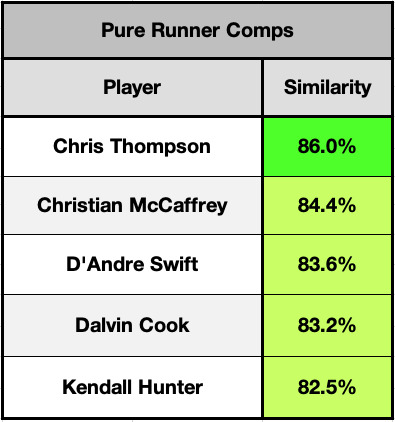
Unfortunately, box count data is available for only D’Andre Swift among these players. And he was similarly volatile during his time Georgia. Chris Thompson is my favorite comp for Cook. They were both small, underutilized players who were dynamic on the ground and through the air.
Receiving Chops
The second part of that Chris Thompson comparison is where James Cook really shines. He might be the best receiving back in this class:
His involvement in the passing game was low from a market share perspective. But his receiving production was incredibly high in the context of his overall role in the offense.
He also wasn’t just thrown to frequently, but was used in dynamic ways. Being moved around the formation and targeted downfield both speak to the high level of positional versatility that Cook offers. That being a “running back” who is often more like a wide receiver.
On those advanced targets, Cook was very efficient. A 90.5-percent Catch Rate on a 68th-percentile aDOT is impressive. So is being able to immediately transition into YAC mode after cleanly securing the catch as effectively as Cook did. The average between Cook’s percentiles ranks in Catch Rate and YAC per Reception is 81.7; the second-best in this class and the highest among any back with a positive aDOT. The next best guy in that category is Jerrion Ealy. He posted a 64.5 in the same metric while catching passes less than half as far downfield as Cook.
Given the above metrics, here are the historical prospects whose receiving profiles most closely resemble Walker’s:
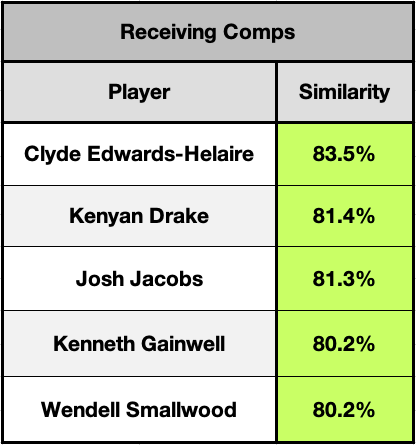
These are all decent comps. But none can match the mix of versatile alignment, downfield play, and strong hands that Cook offers. Kenneth Gainwell comes the closest. Though Cook did his receiving damage in the SEC while Gainwell ripped apart the American Conference.
Overall Profile
James Cook is an interesting evaluation. He’s one of the most dynamic receiving backs we’ve seen in recent years while offering explosive production on the ground. But backs with his frame don’t often fill fantasy-friendly roles. It has happened before. Guys like Jamaal Charles, Reggie Bush, and Chris Johnson were similarly built and produced like RB1s in fantasy.
The difference between Cook and those players is that they were all productive lead backs in college. Buzz leading up to the Draft indicates that NFL teams love Cook’s skillset. We could see him taken as high as the second round. In that event, it’s possible that a smart team is creative enough to let him loose in a Charles-type role. One that allows him to get out in space and maximize his talents.
That’s possible, but it’s a tough ask. The more likely outcome is that Cook is a Chris Thompson-type role player at the next level. Given Cook’s overall profile, Thompson is actually one of his closest matches in two key categories. The raw traits comp looks at a player’s complete profile independent of his production to find historical prospects who looked and played like he did on the field. The overall comp adds production back into that equation:
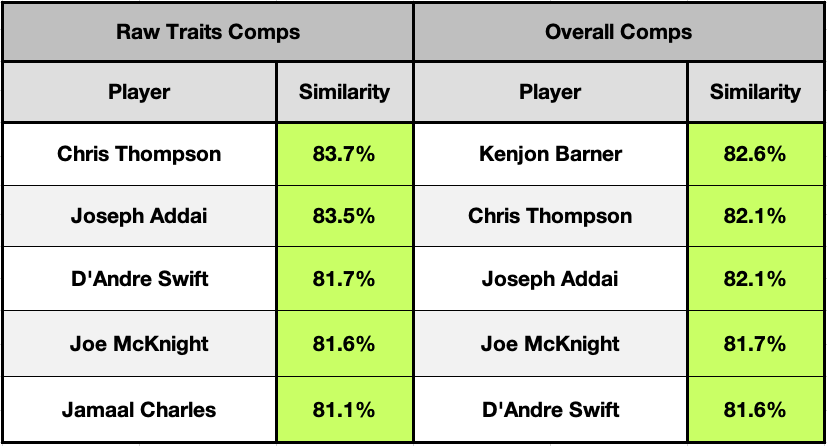
Thompson-to-Cook is really one of the cleanest comp pairings for any back in this class. More advanced data is not available to examine Thompson’s alignment or aDOT or box count numbers relative to Cook’s, but they’re very similar from a bird’s eye view in every area.
Last Word
I view that comparison as a compliment. I’m more confident that NFL coaches will find ways to maximize the talents of a versatile weapon like those guys in 2022 than I would’ve been back when Chris Thompson entered the league nearly a decade ago. The early expected draft capital for James Cook speaks to that. Whereas Thompson was selected with a fifth-round pick back in 2013.
Cook’s range of outcomes is wide. But he has the ability to be one of the more productive pass-catching backs in the league early on in his career. That could give him Nyheim Hines-like fantasy utility; which is unfortunately much less valuable than it is in real life. Potential for more exists, but the odds we see a fully unleashed Cook seem low.



